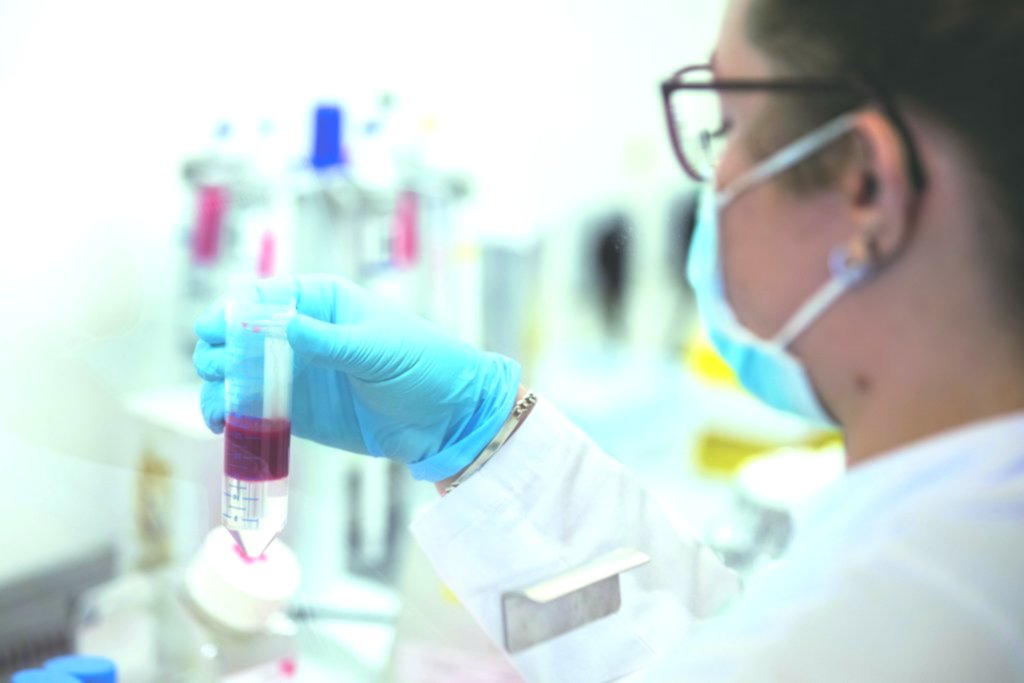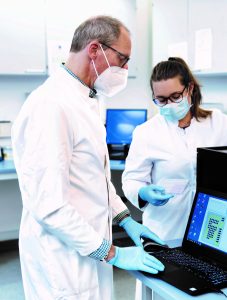
With nanotechnology, gold and lasers: At the University of Duisburg-Essen, researchers are developing an unusual method to stop the growth of tumors.
NANOTECHNOLOGY: SCIENCE OF THE SMALLEST DIMENSION
When Ronja Schirrmann entered the laboratory on Tuesday morning at half past eight, she was one of the first in her work group. It will be a long day, the young scientist has known since she planned today’s experiment. Twelve hours minimum – that’s how long it takes until she has gone through the complex series of experiments step by step and can collect the first data. Schirrmann works at the Clinic for Ear, Nose and Throat Medicine at the Essen University Medical Center. She is part of a research team that conducts science in the smallest of dimensions – at the level of nanoparticles.
The word “nano” comes from the Greek and means “dwarf”. Incredibly tiny would be more appropriate: a nanometer is a billionth of a meter, roughly the size of an apple compared to the size of the earth. In the future, gold nanoparticles will help kill harmful cells. Other ingredients for this idea are antibodies and laser beams.
IN THE SIGHTS: HARMFUL IMMUNE CELLS
The research team is not aiming for the cancer cells themselves, but for their helpers: immune cells that are supposed to protect the body, but have now changed sides. “We are working on removing one of its most important tools from the tumor – the body’s immune system reprogrammed cells,” explains Schirrmann.
Usually the immune system is trained to shut down threats. But tumor cells can reprogram immune cells. “The immune cells then help the tumor to continue to grow, to form new blood vessels or to spread throughout the body. The immune response to the threat is suppressed and drugs become ineffective. We want to prevent that by killing the reprogrammed immune cells. “

RECIPES FROM THE NANO KITCHEN
But first Ronja Schirrmann has to get the target objects of her experiment ready for use. First, the appropriate immune cells are isolated from blood samples – a process that takes up a large part of the morning. When the cells are ready, the next step is to mix them with the various ingredients from the nano kitchen. The first ingredient is formed by special antibodies that recognize certain surface molecules on the harmful immune cells and attach themselves to them. “Our therapy should only kill immune cells that have become malignant,” explains Schirrmann. “The healthy immune cells remain untouched. “
Another ingredient are molecules coupled to the antibodies, which only become active when the antibodies have connected to their matching tumor immune cells. Then they literally grab the last ingredient in this mixture: tiny nanorods made of gold. Ronja Schirrmann gives the nano tools about an hour to recognize and bind to their target. Time enough for her to have a bite to eat and talk to her boss, Professor Dr. Sven Brandau to pay a visit.
IMMUNOTHERAPY 2.0
For more than 20 years, the biologist has been working on immunotherapies against cancer, which are now firmly established in clinical practice. “But time and again we discover loopholes that tumors exploit to evade the immune system. With the advent of nanotechnologies in cancer medicine, however, new opportunities have arisen for the global research community, ”said Brandau.
VISIONARY NEW CONCEPTS
The Essen project, which the German Cancer Aid supports with 798,000 euros, is part of the “Visionary new concepts in cancer research” funding program. In this way, the foundation supports pioneering and unconventional projects with the aim of treading new and previously untrodden paths in cancer research. “We are very happy that the German Cancer Aid is behind our project,” Schirrmann and Brandau agree. This ambitious project arose in collaboration with Professor Dr. Barbara Saccà from the Faculty of Biology at the University of Duisburg-Essen and Professor Dr. Sebastian Schlücker, Faculty of Chemistry at the University of Duisburg-Essen. “The aim was to combine our knowledge from the respective specialist area in order to be able to develop a targeted cancer therapy.”
STOP TUMOR GROWTH THROUGH NANOTECHNOLOGY
Back in the laboratory: Ronja Schirrmann is now transferring the mixture of immune cell nanoparticles into special vessels. She puts this in a large box that contains an experimental laser specially designed for the project. Schirrmann closes the flap and starts the irradiation program with a click of the mouse: the cells are irradiated with the laser for five minutes. As a result, the nano gold sticks heat up to 70 degrees – enough to literally melt the malignant immune cells. “Such a procedure is known as photothermal therapy,” says Brandau. “If we have optimized this technology for our purposes, we will in future be able to kill cancer-promoting cells in a targeted manner without affecting healthy tissue.”
Discuss video conference with the three working groups involved. The direction is clear: Scientists have already shown that suppressing harmful immune cells can stop tumor growth. Professor Brandau is confident: “We still have a lot of research ahead of us, but we are optimistic that we can further develop this method into a new type of precision immunotherapy.”
EXPERT INTERVIEW: THERAPEUTIC METHOD FOR ALMOST ALL TUMOR TYPES

Professor Dr. Sven Brandau,
Ear, Nose and Throat Medicine Clinic, Essen University Hospital
HOW CAN THE NANOTOOLS IN THE PATIENT GET TO THE TUMOR?
“Antibodies move freely and find their target by themselves. Initially, a direct injection into the cancerous tissue is planned. There the modified antibodies would “freely distribute” and do their job. “
FOR WHICH TYPES OF CANCER COULD THIS PROCEDURE BE USED?
“The principle should be applicable to almost all solid tumor types. The effectiveness depends less on the type of cancer itself, but more on how the tumor is built inside. For example, which cells have flown in. This can be analyzed on tissue sections before the start of therapy and then a decision can be made as to whether the procedure can be used in this special case. “
WHAT ARE THE FUTURE PROSPECTS?
“We are initially developing the technology in the laboratory on isolated immune cells and three-dimensional cell cultures from healthy donors and tumor patients. The next step would then be a preclinical model in which we test the intratumoral injection and the activation of the nanotools by laser light. If successful, the system also forms a platform technology with which basically any target cell can be addressed and then eliminated by laser irradiation. “